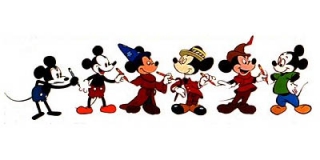The Case for Dog Dressing

‘Tis the season to dress your dog -- much to the dismay of those who revile canine costuming. Such naysayers are wont to quote Fran Lebowitz: “If you are a dog and your owner suggests that you wear a sweater, suggest that he wear a tail.”
I beg to differ. From a genetic perspective, dog dressing is not only acceptable but desirable.
I’m not talking about functional clothing -- shoes to protect sensitive paw pads from corrosive salt on snowy streets, say. That’s a given for those who care about their dogs’ health. I’m making the case for dog adornment: kerchiefs, shirts, hats, and even silly costumes, clothing that serves no apparent purpose except to amuse owners.
Why should that be encouraged?
Because it’s far better than breeding for neotenized -- a.k.a. cute -- characteristics.
Steven J. Gould explained the concept of neoteny, or juvenilization, in The Panda’s Thumb, citing as an example the evolution of Disney’s Mickey Mouse:
A newborn child possesses a relatively large head attached to a medium sized body with diminutive legs and feet. This gradient is reversed through growth as legs and feet overtake the front end. Heads continue to grow but so much more slowly than the rest of the body that relative head size decreases ...Children, compared with adults, have larger heads and eyes, smaller jaws, a more prominent, bulging cranium, and smaller, pudgier legs and feet...
Mickey, however, has traveled this ontogenetic pathway in reverse during fifty years among us. He has assumed an ever more childlike appearance as the ratty character of Steamboat Willie became the cute and inoffensive host to a magic kingdom. The Disney artists transformed Mickey in clever silence, often using suggestive devices that mimic nature's own changes by different routes. To give him the shorter and pudgier legs of youth, they lowered his pants line and covered his spindly legs with a baggy outfit....His head grew relatively larger and its features more youthful.
-- from "A Biological Homage to Mickey Mouse" (1978)
Our dogs have been similarly juvenilized -- in real life, and much to the detriment of their health. Over generations, the adults of many of our favorite breeds have become increasingly puppy-like: small, with short snouts, floppy ears, and large eyes.
A prime example of is the Cavalier King Charles spaniel, a dog bred for its neotenized looks and subject to a very painful, debilitating genetic disease called syringomyelia, detailed in the BBC's Pedigree Dogs Exposed. The disease is described on the Cavalier Health site as occurring “because the back half of the Cavalier King Charles spaniel’s skull is too small to accommodate all of the brain’s cerebellum, which may also be too large, and so it squeezes through the foramen magnum – the hole at the back of the skull – partially blocking the flow of cerebrospinal fluid (CSF) down the spinal cord.”
And that’s just an extreme example. More common are the breathing problems to which bracycephalic (smushed face) breeds such us pugs are subject. Many bracycephalic dogs also have eyes so protuberant that they have been known to pop out of their heads.
Not cute.
In contrast, dog dressing gives us our cuteness fix without the need to breed for it.
I’m not the only responsible dog owner who advocates the practice (although I don’t know that anyone else has offered a scientific justification for it). Many shelters post pictures of the dogs that they want to adopt out wearing natty outfits. And for the last two years, to celebrate Prevention of Cruelty to Animals Month, the ASPCA asked supporters to send pictures of their furry friends in orange outfits. “Dress Your Pet To Fight Cruelty,” the contest promo said in 2009.
Even so-called scary breeds look cute in clothes.
In addition, dog dressing promotes positive training. Few people are tempted to perform alpha rolls or other domination-based training techniques on dogs wearing clothes. This is partly because the dogs seem less threatening, and partly because would-be dominators are likely to find it hard to take themselves as seriously as they tend to do. It’s really tough not to laugh at a dog in a tutu.
Ok, a few caveats: You don’t want canine clothing to be uncomfortable -- or worn too long or too often. Dogs can’t communicate with each other very well when they’re clothed. And a little anthropomorphism goes a long way.
But if you feel like duding your dog up on Halloween, go ahead. Most dogs don’t mind -- yours will let you know if there’s a problem -- and future canine generations may thank you for it.




